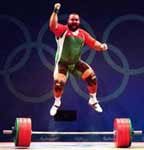AH-HA! I bet most of you have started reading this article expecting to learn basics about weight training. Nope, I am not going to go there. The title of this article itself shows the great need to go back and learn what the iron game originally had to offer and where it has gone. Weightlifting is the sport we most see in the Olympics. It involves the competitive lifts; Snatch and Clean and Jerk. While many people have probably no interest in ever competing in such a sport, Weightlifting has a lot to offer for those interested in high levels of strength and/or sports performance.
Is Weightlifting Safe?
 Somewhere Weightlifting gained the reputation of being a dangerous endeavor. This idea was actually a marketing tool that was used by many of the uprising machine companies of the 60's and 70's. The machine manufactures wanted the public and gyms to believe that everyone could obtain the same benefit using their equipment without the risks posed by Weightlifting and Powerlifting. This idea worked as far as marketing goes, we have seen the complete disappearance of platforms and bumper plates from schools and some major training facilities and even more scary the slow disappearance of squat racks and deadlifting.
Somewhere Weightlifting gained the reputation of being a dangerous endeavor. This idea was actually a marketing tool that was used by many of the uprising machine companies of the 60's and 70's. The machine manufactures wanted the public and gyms to believe that everyone could obtain the same benefit using their equipment without the risks posed by Weightlifting and Powerlifting. This idea worked as far as marketing goes, we have seen the complete disappearance of platforms and bumper plates from schools and some major training facilities and even more scary the slow disappearance of squat racks and deadlifting.
What has this caused? Unfortunately we have seen more and more people that are pathetically weak and inflexible from all the time they spend on machine and isolated training. I have worked with a significant number of athletes and it is astounding the lack of flexibility and functional strength these individuals posses. Even though they may be able to leg press a ton of weight or have impressive bench presses, very few can execute a basic lift like an Overhead Squat. Have injuries decreased? Nope, we have seen an increase in low back injuries. However, was this idea of Weightlifting being dangerous even true? Here are two main points to consider:
- The International Weightlifting Federation most recently reported an injury rate of the spine of 8%. This is amazing considering the loads that these athletes lift and the frequency in which they train with these weights. Does anyone want to venture how many injuries are caused by long distance running or American Football?
- Weightlifting has a lower incidence of injury than recreational lifting, tennis, track and field, and many other popular sports (1). Weightlifters have been shown to suffer an injury every 166,000 hours of training. Pretty good especially when you see athletes lifting twice their bodyweight overhead.
Some may also question whether or not ballistic actions are safe to the soft-tissues. It is important to remember that tissues have an elasticity quality to them and will not break under sudden loading, which is very evident, every time we run or jump. Tissues also develop under a level of specificity. If someone participates in an activity that requires ballistic actions they need to integrate this form of training into their program otherwise they actually increase their risk of injury as they will not be able to tolerate the loads as efficiently.
Why Weightlifting?
The competitive lifts as well as their variations are unique as there no other lifts that use as many muscles and stimulate the nervous system in the same manner. Anyone that has ever performed a Snatch, Overhead Squat, Split Clean or any of the million of other variations can attest that new muscles are trained in a way that could never be replicated by machines. Research has also shown that strength is a large byproduct of adaptation by the nervous system.
This is especially important to athletes that must learn how to coordinate movement in so many different planes of motions at the same time.
Weightlifting is crucial for the development of Rate of Force Production. This often forgotten concept of athletic development is very important for distinguishing how much "functional" strength an athlete possesses. Most studies will state that the time to develop maximal force is approximately .4 seconds. This may not seem very long; however, most sporting movements last approximately .18 seconds. So, it should become clear that it is not the strongest athlete that always wins, but the athlete that can produce the highest amount of force in the shortest amount of time. Because of the ballistic actions used in Weightlifting, Rate of Force Production is trained in a useful manner. Most of the power in sports comes from the hips and trunk. These lifts highly train the muscle systems to perform in an explosive manner.

Slow movements have a small transfer to increasing rate of force production so well executed ballistic actions can greatly improve this dimension of strength. I make this distinction because many lifters will tell horror stories of trying to attempt these lifts in high school with tragic results. This is more due to the lack of proper instruction than the exercises themselves. The same can be said of benching, squatting, deadlifting and even curling.
Aren't the Lifts Too Complex?
The reason most lifters never attempt any Olympic lifts is that they have no clue how to perform them correctly or have been taught incorrectly and therefore have had negative experiences. These lifts do have a level of complexity to them, but that is why teaching someone in a progressional manner is important. With any sporting movement we never expect the individual to master the full skill the first time. We usually teach skills in very distinct actions so that we can slowly put all the pieces together, the same should be done with these exercises.
The purpose of this series of articles is to allow anyone to learn how to sequential learn how to properly perform many of the Olympic lifts and their variations. Just to make my point, I have recently taught a 60-year-old woman who never played sports how to Snatch. Some may question if this is safe, but I would have to state that she has trained with me for some time and has gone through a carefully planned level of progressions. Not only does she do a good job with the technique, she has a blast performing them!!
Next time we will start to look at how to prepare our bodies for these lifts. They will provide much needed variety and new levels of strength to those that have never performed them. We should now be looking forward to new levels of performance and getting psyched to achieve feats we never thought possible!

References
1. Brian P. Hamill, "Relative Safety of Weightlifting and Weight Training," _Journal of Strength Conditioning Research, Vol. 8, No. 1(1994): 53-57
